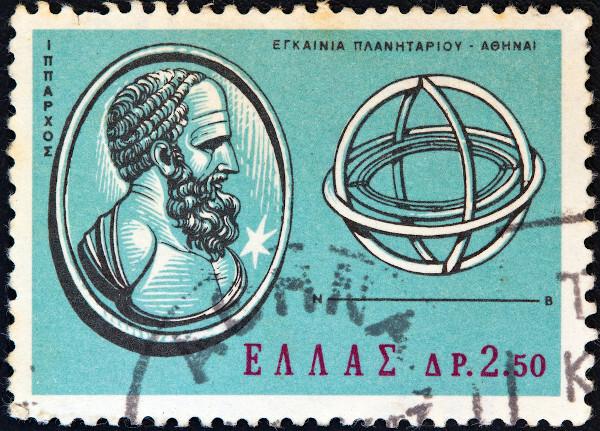O astrolabe It is a calculation, measurement and observation instrument used to determine the position of the stars in the sky and to indicate the altitudes and depths. With this information it was possible to calculate the hours, latitude, cardinal points and directions. to be followed, as well as identifying when a certain celestial event happened, such as the time of sunrise Sun, for example.
Perfected by Arabs and widely used by Europeans in the Great Navigations, the astrolabe was an extremely useful and versatile instrument that was very important for orientation on the earth's surface and for studies in the field of astronomy.
Read too: Rose of the Winds — representation that presents the cardinal and collateral points
Summary about the astrolabe
The astrolabe is a calculation, measurement and observation instrument that was perfected and spread by the Arabs from the sixth century, although the first writings that gave rise to the object itself are by Hipparchus of Nicaea (190 yr. C.-120 a. W.).
This instrument was widely used by Europeans during the Great Navigations.
The astrolabe serves to determine the position of the stars in the sky, measuring its angle with respect to the horizon and also to find altitudes and depths. This calculates the latitude, directions and Cardinal points, time of day, timing of celestial events such as sunrise and sunset.
It is formed by a representation of the main stars in the sky, engraved on the tympanum, and other elements such as the mater, wheel, rete, alidade and ruler.
It was very important for its versatility and great utility for orientation and location in space.
Due to the large number of functions it performed, the astrolabe is often called an analog computer.
Origin of astrolabe
Studies on the methodology applied in the construction process and in the use of astrolabes date from 2nd and 1st centuries BC. W., having been held in Alexandria. The main mathematical theorems and discoveries in the field of Astronomy and the Geography that allowed the development of this instrument are derived from the work of Hipparchus of Nicaea (190 a. C.-120 a. W.). Among other contributions, Hipparchus calculated the distance between the Earth and the Moon, discovered the precession of the equinoxes and the duration of one year, in addition to being considered the father of Trigonometry.

The first planisphere, or world map, made by the Greek astronomer and geographer Claudius Ptolemy (90-168), was equally important in the development of the astrolabe. Some writings attribute to Ptolemy himself the elaboration of one of the first systems of location and calculation of distances that was called astrolabe. Mentions of the astrolabe were made by Theon of Alexandria (335-405) in the 1st century of the common era, which are believed to have served as the basis for the improvement of this object during the Middle Ages, and also by Synesius of Cyrene (373-414).
Writings from the 6th and 7th centuries indicate that the actual use of the astrolabe dates from this period, although it is not possible to date exactly when this happened.
You countries arabsadded new elements and functionalities to the astrolabe, in addition to spreading its use between the 8th and 9th centuries through the translation of ancient texts written in the Greek language. This instrument was mainly important in determining the time and spatial orientation, functions that were also widely used by followers of the faith iIslamic when performing the traditional rites of the religion, finding the direction in which the city of Mecca was located, for example, and determining with greater precision the times of prayers.
The astrolabe came to be widely used in West Asia and Northern Africa. Africa, from where it headed towards the European continent. He was during the Middle Ages that this instrument became more used in Europe, gaining more and more popularity as it proved to be very useful in various activities. Its apex took place during the 15th and 16th centuries, when it received the important role of a navigation instrument used in spatial orientation.
Read too: Compass — a guidance instrument created by the Chinese
What is the astrolabe used for?
The astrolabe is an instrument that it presents various functions. It serves for:
determination of hours by positioning the stars in the sky;
determining the time of a celestial event, such as sunrise or sunset;
determining the angle of the Sun, stars and Moon with respect to the horizon or from its zenith;
determination of the distance in degrees of the stars in relation to the equator line, which results in your latitude and helps in identifying positions and displacements across the Earth's surface;
find north and, consequently, the other cardinal points, which is also useful in locating and navigating;
measurement of the distance of a star in relation to the terrestrial surface, that is, its height;
altitude and depth measurement.
What are the parts of the astrolabe?
![Components of a medieval planisphere astrolabe. [2]](/f/818c93eaa600027df74f44482eb255c1.jpg)
An astrolabe is made up of the following components:
Mother: main plate on which the other parts of an astrolabe rest. It has a graduated edge that is thicker than the rest of the disc. This edge is called the limb or wheel.
Limbo (or wheel): edge that features a graduated scale divided into 360°, with subdivision into quadrants of 90° indicating the zenith. There are also other gradations, which provide information on hours (divided into 24 hours) and the position of a star on the ecliptic (divided into days and months).
Eardrums: plate located inside the mater. It presents a series of engraved lines that serve to determine the latitude, also indicating elements of the celestial sphere (equator and tropics) that appear as a star map.
Rete (or spider): positioned over the eardrums, rotating around the central pin. This component was used to determine how high a star was and its direction.
Alidade: needle located at the back of the astrolabe with the function of measuring the altitude of the stars. By pointing it at the sun, it is possible to determine the time of day.
Ruler (or needle): used to record the measurements read on the graduated scales, in addition to making their correlation with the time scale.
How does the astrolabe work?
For the measurement of the position of the stars to be done properly, the astrolabe must be maintained vertically, without oscillating, so that the central line, which would be the equator, is parallel to the ground or sea level, as when this instrument was used for navigation. Once in this position, point the needle in the direction of the star (a specific star, in this case) or the top of the object whose altitude being measured at that moment, using the angle formed with the horizon and the reading of the gradation scales for information desired.
With these seemingly simple steps, it was possible to perform several calculations to identify the latitude and position on the surface. terrestrial, the calculation of the hours — which were found using the alidade — and of celestial events such as the time at which the Sun rose, for example.
Read too:Latitudes and Longitudes—What's the Difference?
importance of astrolabe
The astrolabe was a instrument of great importance for the location and orientation in space, especially during the period of the Great Navigations. It contained a representation of the main stars in the sky, making it possible to calculate the position latitudinal and celestial phenomena, in addition to its usefulness in calculating the altitude and depth of other objects.
Because of this, the astrolabe is often described in the literature as a very practical analog computer and even advanced to the period in which it was most used, still playing an important role in other fields of knowledge, such as Mathematic and Astronomy.
Facts about the astrolabe
The word “astrolabe” is of Greek origin and means “conqueror of stars”.
The planisphere astrolabe is the most common type of astrolabe.
The Museum of the History of Science, located in Oxford, in the UK, brings together the largest collection of astrolabes in the world.
Angular scales and circles for azimuths were added to astrolabes by the Arabs.
The first records of the use of the astrolabe in Europe occurred in Spain.
In the Middle Ages, astrolabes were also used in the teaching and learning of astronomy.
image credits
[1] Lefteris Papaulakis / Shutterstock
[2] Wikimedia Commons (reproduction)
By Paloma Guitarrara
Geography Teacher

